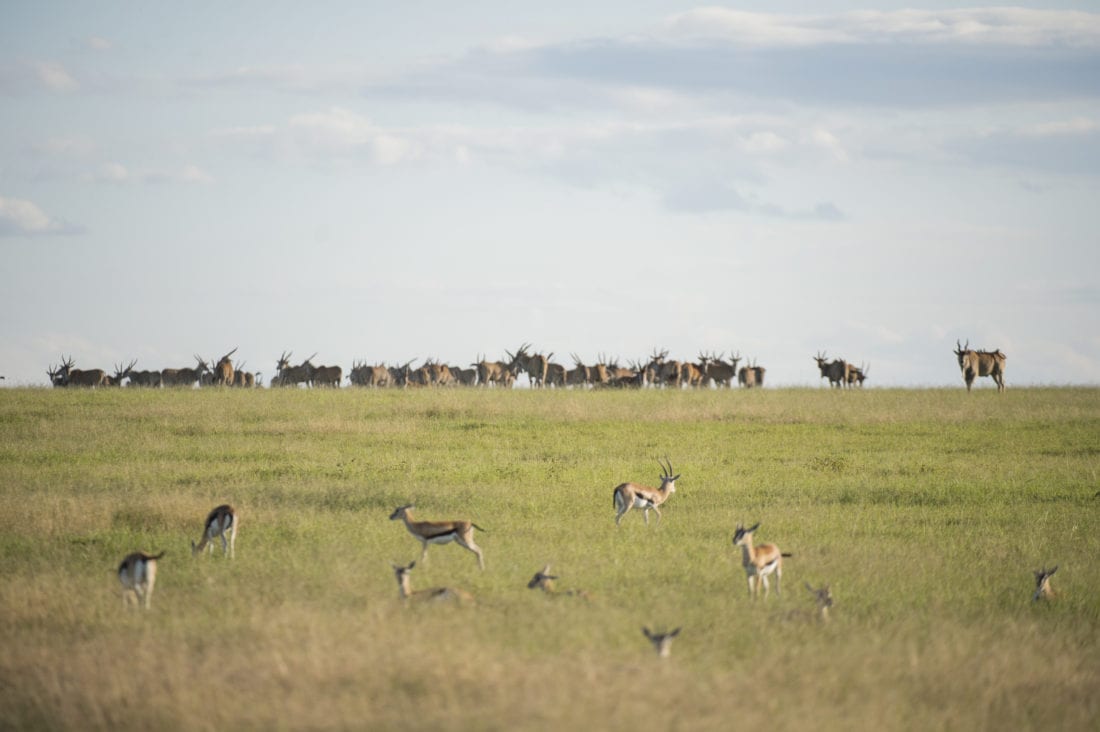Big Mammal Sightings Record Broken
Excerpts from a 24 hour adventure
by Charles Foley, with Lara Foley and Brenden Simonson
In September of this year we approached the management at Grumeti with an unusual request: would they be interested in supporting an attempt to break the Big Mammal Day world record in their concession area? The Big Mammal Day concept stemmed from the much more common Big Birding Day where birding enthusiasts attempt to see as many different species of bird as possible in a 24-hour period – usually midnight to midnight. Certain rules apply; for instance, the participants have to find the animals themselves without outside assistance, the animals must be wild, and they cannot be trapped. My wife, Lara, and I had set the original Big Mammal Day record of 42 species in 2004, covering parts of the Ngorongoro Conservation Area and southern Serengeti National Park. Since then several other groups have attempted Big Mammal Days, and the record was matched in a remarkable effort in California a few years ago. This got us wondering – would it be possible to see as many as 50 species in a single 24-hour period?
To reach 50 species, a site would have to be carefully selected and several important factors would need to be achieved: 1) it would have to be in the tropics, in an area with high mammal species diversity, 2) it would have to be a savanna ecosystem where mammals are relatively easy to see, 3) night driving would have to be possible, as almost 70% of mammal species are either nocturnal or crepuscular, 4) we would have to be able to tap into strong local knowledge of where mammals were likely to be during the reconnaissance phase, 5) we needed to be able to find lots of species of bats, and finally, 6) we needed a solid dose of luck, that indefinable quality that can make or break a Big Mammal Day.

photo by Brenden Simonson
The Grumeti area has all of these qualities. Notably it provides a wide variety of habitat types and is dominated by open savanna offering excellent visibility. Mammal densities in the concession area have increased greatly due to excellent anti-poaching efforts, making many species easier to find. Additionally, parts of the area have also benefited from a rotational burning regime, which have helped create micro-habitats that increase species diversity. If we were to reach 50 mammal species anywhere, we felt Grumeti would be the place. Fortunately, when we approached George Tolchard and Emma Wilson at Grumeti, they enthusiastically welcomed the idea of a Big Mammal Day, both as a means of recording and highlighting the mammal diversity within their concession area, and of having their guides learn some of the more obscure techniques of finding mammals.

October was selected as a time of optimal visibility, being the end of the dry season when the grass would be low, although there would also be the possibility of some early rain resulting in a green flush of new vegetation, which might increase some mammal activity. We were also careful to choose a time when the moon would be both relatively new and would rise late, as nocturnal activity of many small mammals, particularly rodents, declines significantly during periods of bright moon.
The Count Begins
As our watches struck midnight on October 16 we switched on the bat detector to confirm that the bats swooping overhead were indeed Little Free-tailed Bats, but before we saw or recorded one we heard a Zebra braying in the distance. Animals sounds count in this endeavor, so Zebra was our first official species. After that, new species came in thick and fast. Within 15 minutes we already had nine species, including Lion, African Buffalo and Northern Lesser Galago. After an hour and a half we were at 21 species, including both the Common and Large-spotted Genet, and the Scrub and Cape Hare.

By 3am when we stopped for a much-needed cup of coffee, we had added African Civet, White-tailed mongoose, Spotted Hyaena, Crested Porcupine, and several other rodent species to the list, which had now grown to 28 species. In the distance we could hear a pride of lions bringing down some unfortunate prey as we sipped our coffee. At that point we left the open plains and headed towards the river, but now things slowed down considerably. We saw no new species for the next 90 minutes as a gentle fog descended over the river tracks, until we saw a large male leopard walking towards us along the road. He stopped, looked at us for a while, and then turned towards the river to continue his hunt. In the hour before sunrise we added a Tree Hyrax that we had scoped out the day before, and a Yellow-winged Bat coming in to roost in some Acacia trees.

As dawn approached, we headed northwards towards the Ikorongo Game Reserve, where we were hoping to find hyrax, Klipspringer, and possibly some Mountain Reedbuck. This area of the concession was dominated by rolling grasslands dotted with kopjes, which was breathtaking in the early morning light. In the hour after sunrise we added some of the common diurnal species including Topi, African Elephant, Oribi, Vervet Monkey and Olive Baboon. However, despite spending an hour searching for Mountain Reedbuck, the species eluded us. A Klipspringer seen at one of the anti-poaching observation posts was our 42ndspecies, matching our previous record. Then, a group of Dwarf Mongoose scampering along the ground pushed us over the record. As we drove out of the Ikorongo Game Reserve we stopped to scan a hillside and were delighted to see a Roan Antelope halfway up the hill. The guides had told us that there was now only one Roan left in that part of the Serengeti ecosystem, and we had not expected to see this species.

We knew that the key to a successful Big Mammal Day was to see many bat species….we hit the bat jackpot at Fort Ikoma, a small settlement close to the concession area, when one man directed us to the old fort on the hill and said “have a look up there”. The fort was now abandoned and in a state of disrepair – perfect habitat for bat roosts. And indeed, it was full of bats of five different species no less, each using a different part of the fort. Now we just had to hope that all the bats would be in the same roosting spots during our Big Mammal Day.
And indeed they were – or at least most of them were. We returned to Fort Ikoma around 9:00 am on the Big Day and within a few minutes we had found four of the species, but the Horseshoe bat was no longer in the room where it had been the previous day. We walked around some adjacent rooms and the bat detector soon picked up its distinctive sonogram – a series of long calls at exactly 70 kilohertz. And there, tucked away in the corner, was the Horseshoe bat. By the time we left the fort we had 49 species under our belt and were full of adrenalin. The magical 50 mark was within our grasp.
From Fort Ikoma we drove towards a riverine area, hoping to find a Guereza Colobus monkey, when we saw something cross the road ahead: a Slender Mongoose. Our 50thspecies, and it was only 9:40 in the morning. We sat in silence for a while, stunned by how much we had seen already, less than half way through the Big Day. Within an hour we had added the colobus monkey, Banded mongoose, and hippo, three of which were living in a pool close to Sasakwa Lodge. We had seen 53 species and it was now 10:30 am. The problem was, we were running out of species that we could reasonably expect to see during the day. One diurnal species still eluding us was the Steenbok, which we had seen the previous day in the Ikona Wildlife Management Area. Clearly not used to vehicles, the Steenbok had run off at high speed once it saw us.

Over lunch we looked at the list and wondered whether a target of 60 animals might indeed be possible….At 3pm we were on our way again, this time with a new crew of drivers: Edward Ayo, one of the long-term Grumeti guides, and Eliakunda Musa. We decided that we would head to the Sabora area first to try to find a Bat-eared fox and ArvicanthisGrass rat, and then wait until dark for a furtive search for the Acacia rat in the trees close to Sabora Camp, after which we’d zoom back to Sasakwa Lodge to try to see the Galago. After that we’d hopefully have a few more nocturnal hours to perhaps look for the Steenbok again and track down any other species we could find. If all went to plan, we might be able to push the record into the high 50s, and possibly even hit 60.
Twenty minutes after leaving the lodge, Lara and I were blithely chatting away with Edward, when Brenden shouted “mouse”! It had run across the road and hidden in a small clump of vegetation. The only diurnal rodent likely to be out at that time was the Grass rat, so we positioned the vehicle some 30 yards from the bush, and within a few minutes three or four Grass rats, which are social animals, had emerged to feed around the clump. Number 54.
On we sped, across the magnificent short grass plains of the Grumeti Game Reserve, stopping occasionally to scan the horizon. On one of these stops Lara suddenly exclaimed, “Cheetah!” and sure enough there was a young male sitting some distance away under a tree. Pausing only long enough for Edward to call the sighting in to the other guides, we went off in pursuit of the Bat-eared fox. We arrived at a known den, which was surprisingly close to a Spotted hyeana den, but there was no sign of the foxes. We waited for a while but, with nothing happening, decided to keep on looking for other species and return to the den at dusk. The drive yielded no new species, and the foxes had not appeared back at the den either. We waited for about 30 minutes before deciding that they were unlikely to show and that we needed to keep moving. By then the sky ahead of us had become increasingly dark as a classic Serengeti thunderstorm materialized out of nowhere. Soon lightning bolts were covering the sky in an impressive display of pyrotechnics, and we hurried across the plains to Sabora Camp.

We arrived at Sabora in the dark and we sat on the camp’s veranda feeling rather gloomy, watching the storm approaching. There had been thunderstorms on both of the previous evenings, which had been followed by an hour or two of rain, although neither of those were on the scale of this storm, which promised to be extremely wet. Many mammal species take shelter during heavy rains, and we were contemplating the idea of the attempt being over or, at best, losing several hours of searching for new mammals. On the bright side, however, we had seen already 55 species, decimating the old record, and the cup of tea that the lodge staff served us while we waited was excellent. After an hour or so of waiting, we noticed that the lightning had moved past the camp, and quite remarkably, there was no rain following behind it. Perhaps we might be able to pick up some more species after all.

photo by Brenden Simonson
Once the lightning was well out of the way, we started searching in the trees behind the camp for Acacia rats. We weren’t really expecting to find one, particularly this soon after a major storm, so it came as a real shock when I saw the characteristic white belly and black face stripe of an Acacia rat looking down at me from its perch a few meters up the tree. I let out a rookie’s yell of surprise, and the rat disappeared. Revitalized, we jumped in the car and headed off rapidly toward Sasakwa Lodge to try to find the Greater Galago. As we approached Sasakwa hill, a tiny brown bat flew in front of the open windscreen. I scrambled for the bat detector and saw the characteristic sonogram of a Banana bat. Species number 57!
We arrived at Sasakwa Lodge at around 9:00pm, just as some of the guests were entering the dining room for dinner. We were there for little more than ten minutes before a Galago appeared, grabbed some tasty looking aperitif and scurried back to the bushes. Now, we had a little under three hours to find two more species of mammal to reach 60. Surely we could do this?!
Leaving the lodge we drove along the edge of Sasakwa hill, in the transition zone between the rocky hillside and the grasslands. This stretch of road had proven particularly productive for rodents, and we had seen numerous Fringe-tailed Gerbils, several Mus (a very small mouse), and a Bush rat during the early morning hours. “Mouse”, shouted Brenden again as a smallish grey mouse ran across the road. Fortunately, instead of disappearing into a clump of grass like many of the other rodents we were seeing, it stayed in a relatively open patch of ground, and Brenden leaped out of the vehicle to try to corner it. The mouse froze, allowing us to get a good look at it through the binoculars – a Multimammate mouse, one of the most common and widespread rodent species in Tanzania, and one that we had been expecting to see on the Big Day. Finally it was on the list on 9:42pm. Number 59.
Now we just had to drive around and hope that something unusual showed up if we were to get to 60. At that point a few rain drops started falling, and the dark clouds overhead seemed to thicken. Yet the mercurial weather patterns of the Serengeti played their last trick on us, and within a few minutes the rain had stopped and the clouds rolled away, revealing the moon for the first time that evening. Round and round we drove, stopping regularly to check eye-shine. The density of wildlife in the Sasakwa area is simply astonishing, and we saw large numbers of hyeanas, genets, springhares, lions, another porcupine, herds of several thousand wildebeest, and even a hippo wandering around the plains to feed, but nothing we hadn’t recorded yet. By this point we had been awake and on the move for over 22 hours, and we were starting to flag. Fortunately, Edward (Ayo) kept our spirits up, telling us about the interesting mammals he had seen in the past in each area we were driving through and keeping up our motivation. Driving through an area of open bushland in the WMA, the vehicle turned the corner and Lara and Brenden both saw a small buck at the edge of Brenden’s spotlight beam. “Stop”, they both shouted, and Brenden fixed the light on the animal to reveal a Steenbok. We had pretty much given up on seeing one, but here it was, in an area where Edward had never seen them before. It was just the slice of luck that we needed. The time was 10:38 pm and we had seen 60 mammal species!

photo by Brenden Simonson
Seeing 60 different mammal species in a single day is an astonishing achievement. We could not find a comprehensive mammal species list for the Grumeti area, but we estimate it is probably just over 100 species, meaning we saw close to 60% of all of the mammalian fauna in a single day.
While this particular record might be difficult to beat, our goal is to encourage people to try to set Big Mammal Day records around the world, even in countries such as England, or states like New York, where numbers are likely to be low. Part of the fun of a Big Mammal Day is the excitement and adventure of getting into nature with a specific goal: to see as many mammal species as possible. It also encourages budding naturalists to explore at night, revealing a whole new world of mammal species that are otherwise rarely seen. Ultimately, though, it’s about inspiring people to enjoy, appreciate, and learn about the nature around them, wherever they may be living.
Charles and Lara Foley have studied the elephant population in Tarangire National Park for the past 25 years. They were also the lead authors on the ‘Field Guide to the Larger Mammals of Tanzania’. Brenden Simonson grew up in Tarangire National Park, where he is a guide and photographer based at the Tarangire Safari Lodge.

photo by Brenden Simonson
Table 1: Big Mammal Day species list
| No. | Species | Latin name | Time seen |
| 1 | Plains Zebra | Equus quagga | 12:00 |
| 2 | Little Free-tailed Bat | Chaerephon pumilus | 12:00 |
| 3 | Northern Lesser Galago | Galago senegalensis | 12:05 |
| 4 | African Buffalo | Syncerus caffer | 12:05 |
| 5 | Impala | Aepyceros melampus | 12:07 |
| 6 | Bush Duiker | Sylvicapra grimmia | 12:07 |
| 7 | African Savanna Hare | Lepus victoriae | 12:10 |
| 8 | Lion | Panthera leo | 12:11 |
| 9 | Waterbuck | Kobus ellipsiprymnus | 12:15 |
| 10 | Pygmy Mouse | Mus spp. | 12:17 |
| 11 | Large-spotted Genet | Genetta maculata | 12:19 |
| 12 | Kirk’s Dikdik | Madoqua kirkii | 12:30 |
| 13 | Common Eland | Tragelaphus oryx | 12:35 |
| 14 | Bohor Reedbuck | Redunca redunca | 12:37 |
| 15 | Bushbuck | Tragelaphus scriptus | 12:41 |
| 16 | Common Wildebeest | Connochaetes taurinus | 12:42 |
| 17 | White-tailed Mongoose | Ichneumia albicauda | 12:52 |
| 18 | Common Genet | Genetta genetta | 01:02 |
| 19 | Giraffe | Giraffa camelopardis | 01:15 |
| 20 | Veld Rat | Aethomys spp. | 01:17 |
| 21 | Cape Hare | Lepus capensis | 01:30 |
| 22 | Grant’s Gazelle | Nanger grantii | 01:47 |
| 23 | Thomson’s Gazelle | Eudorcas thomsonii | 01:50 |
| 24 | African Civet | Civettictis civetta | 01:59 |
| 25 | Fringe-tailed gerbil | Gerbillisscus robustus | 02:19 |
| 26 | Spotted Hyaena | Crocuta crocuta | 02:23 |
| 27 | Crested Porcupine | Hystrix cristata | 02:39 |
| 28 | East African Springhare | Pedetes surdaster | 02:44 |
| 29 | Leopard | Panthera pardus | 04:22 |
| 30 | Southern Tree Hyrax | Dendrohyrax arboreus | 05:20 |
| 31 | Mops bat | Mops spp. | 05:26 |
| 32 | Yellow-winged Bat | Lavia frons | 05:40 |
| 33 | Oribi | Ourebia ourebia | 06:17 |
| 34 | Black-backed Jackal | Canis mesomelas | 06:20 |
| 35 | Topi | Damaliscus lunatus | 06:26 |
| 36 | Savanna Elephant | Loxodonta africana | 06:32 |
| 37 | Vervet Monkey | Chlorocebus pygerythrus | 06:37 |
| 38 | Olive Baboon | Papio anubis | 06:38 |
| 39 | Coke’s Hartebeest | Alcelaphus buselaphus | 06:52 |
| 40 | Bush Hyrax | Heterohyrax brucei | 07:00 |
| 41 | Common Warthog | Phacochoerus africanus | 07:12 |
| 42 | Klipspringer | Oreotragus oreotragus | 07:33 |
| 43 | Dwarf Mongoose | Helogale parvula | 08:09 |
| 44 | Roan Antelope | Hippotragus equinus | 08:35 |
| 45 | Wahlberg’s Epauletted Fruit Bat | Epomophorus wahlbergi | 09:00 |
| 46 | Horseshoe Bat | Rhinolophus spp. | 09:20 |
| 47 | Slit-faced Bat | Nycteris spp. | 09:27 |
| 48 | Leaf-nosed Bat | Hipposideros spp. | 09:29 |
| 49 | Egyptian Tomb Bat | Taphozous perforatus | 09:30 |
| 50 | Slender Mongoose | Herpestes sanguineus | 09:40 |
| 51 | Guereza Black-and-White Colobus | Colobus guereza | 09:54 |
| 52 | Banded Mongoose | Mungos mungo | 10:20 |
| 53 | Common Hippopotamus | Hippopotamus amphibius | 10:25 |
| 54 | Unstriped Grass Rat | Arvicanthis niloticus | 15:22 |
| 55 | Cheetah | Acinonyx jubatus | 15:49 |
| 56 | Acacia Rat | Thallomys paedulcus | 20:15 |
| 57 | Banana Pipistrelle Bat | Neoromicia nana | 20:52 |
| 58 | Large-eared Greater Galago | Otolemur crassicaudatus | 21:15 |
| 59 | Natal Multimammate Mouse | Mastomys natalensis | 21:42 |
| 60 | Steenbok | Raphicerus campestris | 22:38 |




